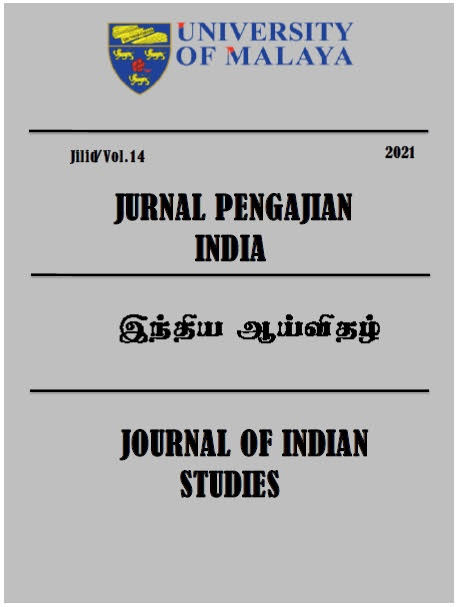THE FEATURES DIFFERENTIATING VĒḶIR, VĒNTAR AND LEADERS AMONG TIṆAIMĀNTAR
வேளிர், வேந்தர், திணைமாந்தர் தலைவர்களை வேறுபடுத்திக் காட்டும் அடையாளங்கள்
Keywords:
vēntar, vēḷir, leaders among tiṇaimāntar, paddy cultivation in ancient Tamilnad, cultivation of dry crops in ancient Tamilnad, fort and eyil., வேந்தர், வேளிர், திணைமாந்தருள் தலைவர், பண்டைத் தமிழகத்து நெல்வேளாண்மை, பண்டைத் தமிழகத்துப் புன்செய் வேளாண்மை, கோட்டையும் எயிலும்.Abstract
The aim of this research paper is to find features to differentiate vēḷir, vēntar and leaders among tiṇaimāntar. U.Ve.Saminathaiyar and A.Sa.Gnaanasampanthan have given a list of features attributed to vēntar. Mu.Rahavaiyangar points out that vēḷir are outsiders without records regarding their identity. Though they are often named with a prefix or suffix of vēḷ; there are instances; a few of which are viz. vandan, pindan, muuvan, pittan, kadalan, kazhuvul etc.; where we are left in a dilemma whether the person is a vēḷ or tiṇaimāntaṉ. So, we have to extract the features pertinent with each category for finalising the lists. A comparative study of the vēḷir, leaders among tiṇaimāntar and vēntar is done with the eight anthologies and the ten idylls as the primary source. Cilappathikaram, the statements of the commentators and the scholars serve as the secondary source. vēntar are unique with their luxury owning four types of forces, a fort with a flag bearing a specific emblem hoisted permanently and a specific garland. References related to paddy cultivation and eyil with occasional flag without emblem prove to be the identity for vēḷir. Associating toddy as the main wealth, occupations like hunting, cattle rearing and cultivation of dry crops prove the identity for leaders among tiṇaimāntar. The fact that the defence tree of vēḷ Nannan was vaakai is ascertained in contrast to the statement of Dr.George L.Hart in his article “Early Evidence for Caste in South India''.
பண்டைத் தமிழருள் வேந்தர், வேளிர், திணைமாந்தருள் தலைவர் என்ற முத்திறத்தாரை வேறுபிரித்தறிய உதவும் கூறுகளை வரையறுப்பது கட்டுரையின் நோக்கமாகும். உ.வே.சாமிநாதையரும் அ.ச.ஞானசம்பந்தனும் வேந்தருக்குரிய அடையாளங்களை மட்டும் கோடிட்டுக் காட்டியுள்ளனர். மு.இராகவையங்கார் 'வேளிர் வந்தேறிகள்' என முடிபு கூறினும் அவரது அடையாளங்களை வரையறுக்கவில்லை. வேள் என்னும் முன்னொட்டு அல்லது பின்னொட்டோடு குறுநிலமன்னர் காணப்படினும் பல வேளைகளில் குறிப்பிட்ட தலைவன் வேளா? அன்றித் திணைமாந்தனா? என்று முடிவு செய்ய இயலாமல் தடுமாற வேண்டியுள்ளது. (எ-டு) வண்டன், பிண்டன், மூவன், கடலன், கழுவுள், பிட்டன் ஆகியோர்; இன்னும் பலர் உளர். திணைமாந்தரினின்றும் வேளிரை வேறுபடுத்த அடையாளங்களைக் கண்டறிந்தால் இவர் வேளிர்; இவர் திணைமாந்தருள் தலைவர் என்று பட்டியல்கள் தயாரிக்க இயலும். எட்டுத்தொகை, பத்துப்பாட்டுகளை முதல்நிலைத் தரவாகக் கொண்டு ஒப்பியல் கோணத்தில் முத்திறத்துத் தலைவரையும் பிரித்து விளக்குகிறது இக்கட்டுரை. இரண்டாம்நிலைத் தரவுகளாகச் சிலப்பதிகாரமும், உரையாசிரியர் ஆய்வாளரின் கருத்துகளும் அமைகின்றன. வேந்தரை அவரது ஆடம்பரமான வாழ்க்கை, கோட்டை, நிரந்தரமாக ஏற்றப்பட்ட கொடியிலுள்ள குறியீடு, நிலையான நால்வகைப் படை, சூடிய மாலை ஆகியன அடையாளப்படுத்துகின்றன. வேளிரை நெல் வேளாண்மை, குறியீடில்லா நாட்கொடி ஏற்றிய எயில் ஆகியன அடையாளப்படுத்துகின்றன. திணைமாந்தரை அவரது பாரம்பரியத் தொழில்களான வேட்டையாடல், கால்நடை மேய்த்தல், புன்செய் வேளாண்மை ஆகியனவும் கள்ளைச் செல்வமெனக் கருதுவதும் அடையாளப்படுத்துகின்றன. முனைவர் ஜார்ஜ் L.ஹார்ட் கருத்தோடு மாறுபட்டு; வேள் நன்னனின் காவல் மரம் வாகை எனும் கருத்தும் நிலைநாட்டப்படுகிறது.

